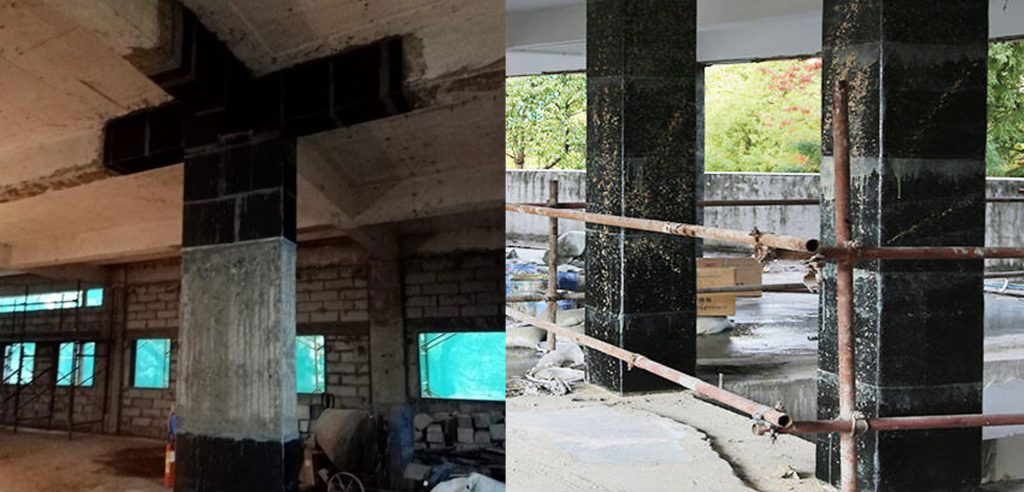Buildings undergo wear and tear over time due to various factors such as environmental stress, seismic activities, and material degradation. Fiber wrapping is one of the most effective modern solutions for strengthening and repairing damaged structures. This technique involves wrapping structural elements with high-strength fiber-reinforced polymer (FRP) composites, which enhance durability, load-bearing capacity, and resistance to external forces.

What is Fiber Wrapping ?
Fiber wrapping is a structural strengthening technique that uses fiber-reinforced polymer (FRP) sheets or fabrics to reinforce concrete, steel, or masonry structures. These fibers, typically made of carbon, glass, or aramid, are bonded to the surface of structural components using high-performance adhesives like epoxy resin.
Why is Fiber Wrapping Important for Building Repair?
Fiber wrapping is essential in modern construction and repair because it increases strength, durability, and resistance against natural disasters like earthquakes. It is widely used in bridges, buildings, and industrial structures to extend their lifespan and improve safety.
Types of Fibers Used in Wrapping
- Carbon Fiber (CFRP) – Known for its high strength-to-weight ratio, excellent durability, and corrosion resistance.
- Glass Fiber (GFRP) – More affordable than carbon fiber but offers moderate strength and durability.
- Aramid Fiber (AFRP) – Offers excellent impact resistance and flexibility, making it ideal for seismic retrofitting.
How Fiber Wrapping Works in Structural Repair
- Surface Preparation – The damaged surface is cleaned, roughened, and free of debris to ensure proper adhesion.
- Application of Primer – A bonding agent is applied to enhance the adhesion between the fiber wrap and the structure.
- Placement of Fiber Sheets – FRP sheets are wrapped around the structural component following specific layering patterns.
- Application of Resin – Epoxy resin is used to bond the fiber sheets to the structure, ensuring strong adhesion.
- Curing Process – The wrapped structure is left to cure, allowing the material to harden and develop its full strength.
Benefits of Fiber Wrapping in Building Repair
1. Increased Structural Strength
Fiber wrapping significantly improves the load-bearing capacity of damaged buildings, allowing them to handle additional stress and weight.
2. Lightweight and High Strength
FRP composites are much lighter than traditional strengthening materials, making them easy to install without adding extra load to the structure.
3. Corrosion and Weather Resistance
Unlike steel reinforcements, fiber wrapping materials do not corrode or degrade due to moisture, chemicals, or extreme temperatures.
4. Cost-Effective Solution
Fiber wrapping is more affordable than conventional repair methods, as it reduces labor costs, material expenses, and downtime.
5. Seismic Retrofitting
In earthquake-prone areas, fiber wrapping strengthens structural elements like columns, beams, and slabs, preventing catastrophic failures.
6. Minimal Disruption During Installation
Unlike traditional repairs, fiber wrapping can be applied without major demolition, allowing buildings to remain operational
Common Applications of Fiber Wrapping
- Bridges and Flyovers – Strengthens weakened bridge piers and decks to enhance load capacity.
- Residential and Commercial Buildings – Reinforces aging structures to meet modern safety standards.
- Industrial Structures – Protects storage tanks, chimneys, and silos from environmental damage.
- Historical Monuments – Helps in preserving heritage buildings without altering their appearance.
Comparison: Fiber Wrapping vs. Traditional Repair Methods
| Feature | Fiber Wrapping | Traditional Repair |
| Weight | Lightweight | Heavy (Concrete & Steel) |
| Installation Time | Quick | Time-Consuming |
| Strength | High | Moderate |
| Corrosion Resistance | Excellent | Low (Steel Can Corrode) |
| Cost | Affordable | Expensive |
Challenges and Limitations of Fiber Wrapping
- Initial Cost of Materials – High-quality FRP composites can be expensive.
- Expertise Required – Proper installation requires trained professionals to ensure effectiveness.
- Surface Preparation – Improper surface cleaning or application can reduce the efficiency of fiber wrapping.
Conclusion
Fiber wrapping is a revolutionary technique in modern building repair, offering a strong, durable, and cost-effective solution for structural strengthening. It provides numerous advantages, such as increased strength, corrosion resistance, and quick installation, making it an ideal choice for residential, commercial, and industrial structures. As technology advances, fiber wrapping continues to be a preferred method for reinforcing buildings and ensuring long-term safety and stability.
Fiber wrapping strengthens not just buildings, but also trust in durability. With Zindus Infra, safeguard your structures for a stronger tomorrow!” 🏢
ZINDUS INFRA (INDIA) PVT. LTD.
- How Structural Strengthening Is Reshaping Mumbai, Thane & Dombivli’s Construction Landscape
- Why Retrofitting is Important for Buildings: Structural Strengthening, Waterproofing & Building Repairs with Zindus
- Seal the Deal: Why Terrace Waterproofing is the Smartest Investment for Old Buildings
- Say Goodbye to Damp Walls! Weatherproof Painting & Waterproofing Secrets Revealed
- Rehabilitation Redefined | Strengthen, Beautify & Protect Old Structures – Zindus

Great insights on how fiber wrapping is transforming structural repairs — especially in aging buildings and rural development zones where traditional methods aren’t always feasible. 💡
Speaking of smart construction and safe investments, for anyone exploring farmland projects like The Breathing Village (which looks absolutely stunning, by the way 🌿), I’d recommend verifying land status, NA classification, and development permissions beforehand.
You can check everything legally and transparently at 👉 http://www.mahabhoomi.site — a platform designed to help buyers make informed land decisions across Maharashtra.
Beautiful landscapes + verified documents = peace of mind. 💯